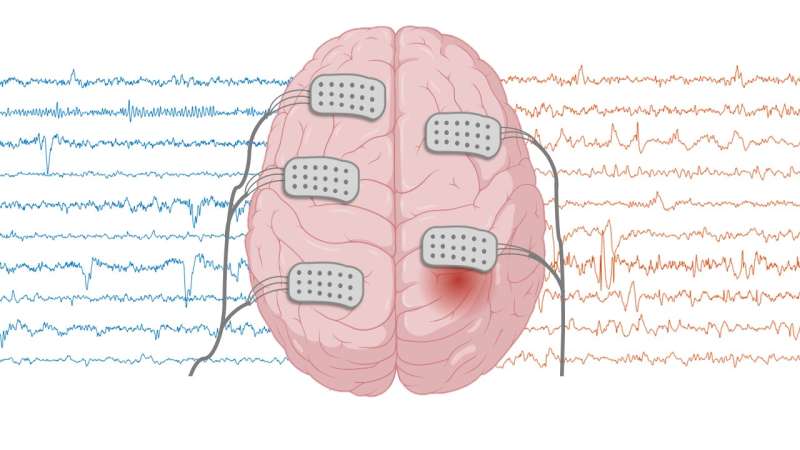Brain signal irregularity may provide clues to understanding epileptic process

Researchers from the UPF Department of Information and Communication Technologies (DTIC) propose a new method to differentiate signals from the epileptic focus from those recorded in other parts of the brain without the presence of an epileptic seizure. This technique may help detect epilepsy-induced features from these signals much quicker than conventional analysis techniques. The results have been published in the journal Physical Review E.
Around 1% of the world's population suffers from epilepsy, a neurological disorder that causes epileptic seizures. In these seizures, a group of neurons displays abnormal excessive neuronal activity in the brain.
But 9% of all epileptic patients suffer from what is known as pharmacoresistant focal-onset epilepsy. In these patients, epileptic seizures cannot be controlled by medication. For them, one potential therapy is the neurosurgical resection of the brain area where seizures start.
Nevertheless, various diagnostic techniques must be performed to try to locate this focus. The brain's electrical activity is measured by means of electroencephalography, a technique that uses electrodes to collect the electroencephalographic signals (EEG signals). In this work, signals recorded using intracranial electrodes (see photo), directly connected to the surface of the brain, to record the patient's electrical activity and thus locate the focus.
But, does this study seek to pinpoint exactly where in the brain the epileptic seizure begins? Anaïs Espinoso, a Ph.D. researcher with the "Nonlinear Time Series Analysis" (NTSA) research group at UPF and first author of the publication, explains that "this is not the goal of the work, the signals of the epileptic focus have a different dynamic from those that do not come directly from the focus. We study these dynamics and we want to achieve the technique that can best accentuate the differences between the two types of signals."
For this reason, they studied the signals produced by five patients suffering from pharmacoresistant focal-onset epilepsy. They applied EEG signal analysis techniques to see various aspects such as phase synchronization and irregularity, a conceptually simple and effective approach to characterize electroencephalographic recordings of patients with epilepsy. Espinoso explains that "many studies of electroencephalographic signals apply complex techniques that encourage the analysis of a large number of patients. These studies, moreover, analyze the signal directly, but this can be altered by physiological artifacts or during the signal acquisition process."
"It is a simple and effective method that allows analyzing various signals very quickly, and you also don't have to wait for the person to suffer an epileptic fit to get results. Suffering a fit can lead to a number of problems for the patient, such as seizures, involuntary muscle movements, loss of consciousness, etc. Thus, signals without epileptic fits gain in importance when it comes to supplementing the diagnosis"
For this reason, in this study the authors obtain the instantaneous phase of the signals. "Obtaining the phase is nothing more than considering that the dynamic of the signal oscillates in a circle every certain amount of time and indicating its position in this circle at every point of time," explains Ralph Gregor Andrzejak, director of the NTSA group and co-author of the publication. "Hence, signal analysis techniques to try to differentiate the signals of the epileptic focus (focal signals) from others recorded in different parts of the brain (non-focal signals) directly analyze this phase."
The results showed that focal signals are more synchronized than non-focal signals. As for phase irregularity, this technique also enables differentiating both types of signals, "focal signals have fewer irregularities than the non-focal ones, the absence of these irregularities is induced by the epileptic process itself," Espinoso continues. "In highly simplified terms, the brain signals involved in the seizure tend to synchronize more easily and be more regular."
The technique in question, the authors point out, is to quantify the irregularity of the phase obtained from the signal. Espinoso explains that "irregularity can be due to several reasons: the noise, non-linearity, stochasticity and non-stationarity of the signal phase."
Andrzejak comments that they had previously studied these signals with other analysis techniques and had not achieved such a high level of difference as in this article.
This technique has several advantages. "It is a simple and effective method that allows analyzing various signals very quickly, and you also don't have to wait for the person to suffer an epileptic fit to get results. Suffering a fit can lead to a number of problems for the patient, such as seizures, involuntary muscle movements, loss of consciousness, etc. Thus, signals without epileptic seizures gain importance when it comes to supplementing the diagnosis," they conclude.
The concept of open science is the idea that scientific research should be accessible to everyone, free of charge. For this reason, the authors of this article have published in public repositories the results and codes obtained in the study. Thus, Espinoso says, "it will be possible to advance in the study of epilepsy more quickly with the help of other researchers."
More information: Anaïs Espinoso et al, Phase irregularity: A conceptually simple and efficient approach to characterize electroencephalographic recordings from epilepsy patients, Physical Review E (2022). DOI: 10.1103/PhysRevE.105.034212



















